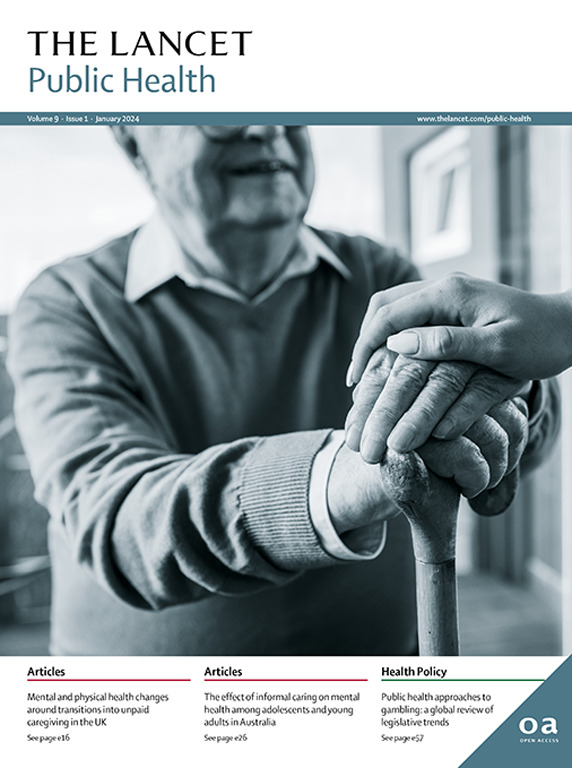The epidemiology and burden of injury in countries of the Association of Southeast Asian Nations (ASEAN), 1990–2021: findings from the Global Burden of Disease Study 2021
IF 25.4
1区 医学
Q1 PUBLIC, ENVIRONMENTAL & OCCUPATIONAL HEALTH
引用次数: 0
Abstract
Background
Injuries are among the top causes of mortality and disability in southeast Asia. Although injury prevention is a key health priority in the Post-2015 Health Development Agenda of the Association of Southeast Asian Nations (ASEAN), the focus was placed solely on road injuries. The absence of a broader recognition of injury burden and trends hinders future intervention efforts. This study aims to provide a comprehensive analysis of the burden and epidemiological trends of all injuries across ASEAN countries.Methods
In this analysis of the Global Burden of Disease, Injuries, and Risk Factors Study (GBD) 2021, we estimated incidence, cause-specific mortality, years of life lost (YLLs), years lived with disability (YLDs), and disability-adjusted life-years (DALYs) by age, sex, location, and year for ten ASEAN member states (Brunei, Cambodia, Indonesia, Myanmar, Laos, Malaysia, the Philippines, Singapore, Thailand, and Viet Nam) from 1990 to 2021. Incidence and non-fatal disease burden were estimated using disease model Bayesian meta-regression (DisMod-MR) 2.1. Mortality was derived from the GBD Cause of Death Ensemble model. Estimates include 95% uncertainty intervals where appropriate.Findings
In 2021, an estimated 35·5 million (95% UI 33·5–37·7) injury incident cases were reported in ASEAN, resulting in approximately 317 000 deaths (286 000–350 000). Substantial variation was observed across the region, with the age-standardised mortality ranging from 13·4 per 100 000 people (12·7–14·1) in Singapore to 68·5 per 100 000 (54·4–81·9) in Viet Nam. Road injury was the leading cause of mortality and morbidity in most ASEAN countries, with the highest age-standardised DALY rates in Thailand and Malaysia. Self-harm was the leading cause of mortality in Singapore, whereas interpersonal violence was the leading cause of injury deaths in the Philippines. From 1990 to 2021, the region's age-standardised injury incidence rate declined by 23·0% (21·8–24·1). Age-standardised DALY rates decreased substantially for drowning (60·6% [53·2–66·7]) and road injuries (39·6% [32·1–46·4]), whereas falls saw a smaller and more heterogeneous decline of 12·3% (2·6–21·0) over the past 31 years.Interpretation
The injury epidemiological landscape in ASEAN is complex, with substantial geographical variations and emerging challenges triggered by the rapid sociodemographic transition in the region. Progress has been uneven. Effective burden reduction across different causes of injury requires strategies addressing the wide range of socioenvironmental determinants and system shortfalls. Prevention programmes need to be customised to each country's unique context and development.Funding
Bill & Melinda Gates Foundation.1990-2021年东南亚国家联盟(东盟)国家的流行病学和伤害负担:来自2021年全球疾病负担研究的结果
在东南亚,受伤是导致死亡和残疾的主要原因之一。尽管伤害预防是东南亚国家联盟(东盟)2015年后卫生发展议程中的一项关键卫生优先事项,但重点只放在道路伤害上。缺乏对伤害负担和趋势的广泛认识阻碍了未来的干预工作。本研究旨在全面分析东盟国家所有伤害的负担和流行病学趋势。方法在对2021年全球疾病、损伤和风险因素负担研究(GBD)的分析中,我们按年龄、性别、地点和年份估计了1990年至2021年10个东盟成员国(文莱、柬埔寨、印度尼西亚、缅甸、老挝、马来西亚、菲律宾、新加坡、泰国和越南)的发病率、原因特异性死亡率、生命损失年数(YLLs)、残疾生活年数(YLDs)和残疾调整生命年(DALYs)。使用疾病模型贝叶斯元回归(DisMod-MR) 2.1估计发病率和非致死性疾病负担。死亡率来源于GBD死亡原因集合模型。估计在适当的情况下包括95%的不确定性区间。2021年,东盟报告的伤害事件病例估计为3550万例(95%为33.5 - 37.7),造成约31.7万例死亡(286 - 35万例)。在整个区域内观察到大量差异,年龄标准化死亡率从新加坡的13.4 / 10万人(12.7 - 14.1)到越南的68.5 / 10万人(54.4 - 89.1)不等。道路伤害是大多数东盟国家死亡和发病的主要原因,泰国和马来西亚的年龄标准化伤残调整年率最高。在新加坡,自残是导致死亡的主要原因,而在菲律宾,人际暴力是造成伤害死亡的主要原因。从1990年到2021年,该地区年龄标准化伤害发生率下降了23.0%(21.8 ~ 24.1)。在过去31年中,溺水(66%[53.2 - 66.7])和道路伤害(39.6%[32.1 - 46.4])的年龄标准化DALY率大幅下降,而跌倒的下降幅度较小,但差异更大,为12.3%(2.6 - 21.0)。东盟的伤害流行病学情况很复杂,存在很大的地理差异,该地区快速的社会人口转型引发了新的挑战。进展参差不齐。有效减轻不同伤害原因的负担需要解决广泛的社会环境决定因素和系统缺陷的战略。预防规划需要根据每个国家的独特情况和发展情况进行定制。FundingBill,梅琳达·盖茨基金会。
本文章由计算机程序翻译,如有差异,请以英文原文为准。
求助全文
约1分钟内获得全文
求助全文
来源期刊

Lancet Public Health
Medicine-Public Health, Environmental and Occupational Health
CiteScore
55.60
自引率
0.80%
发文量
305
审稿时长
8 weeks
期刊介绍:
The Lancet Public Health is committed to tackling the most pressing issues across all aspects of public health. We have a strong commitment to using science to improve health equity and social justice. In line with the values and vision of The Lancet, we take a broad and inclusive approach to public health and are interested in interdisciplinary research.
We publish a range of content types that can advance public health policies and outcomes. These include Articles, Review, Comment, and Correspondence. Learn more about the types of papers we publish.
 求助内容:
求助内容: 应助结果提醒方式:
应助结果提醒方式:


